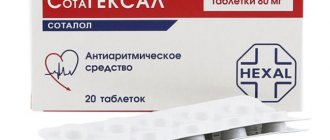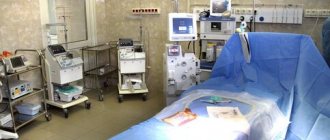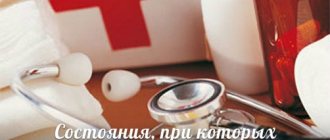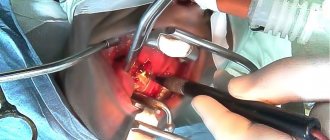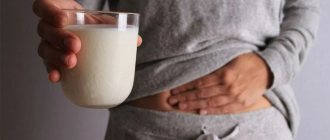Often we are faced with poor health and try to understand what is the cause of this condition. And when many laboratory and instrumental tests have already been carried out and nothing has been found, we think: “What could this be connected with? Because I really feel bad.” If there are no organ damage, it’s time to consult a neurologist. Autonomic dystonia syndrome, autonomic failure, autonomic crises are neurological diseases that we will touch on in this article.
Autonomic dystonia syndrome
Autonomic dystonia syndrome is all forms of disturbance of autonomic regulation, most often secondary manifestations of various pathologies.
There are 3 forms of SVD:
- psychovegetative – a feeling of tightness in the chest, changes in heartbeat, stomach pain, frequent vomiting, headache, dizziness, neuralgia of various locations, problems with urination, increased sweating, changes in the menstrual cycle, feeling cold;
- peripheral autonomic failure syndrome - (see autonomic failure);
- angiotrophalgic - vascular (marbling of the skin, redness, pallor, cyanosis, feeling of numbness, tingling), trophic (peeling and thinning of the skin, spots of pigmentation or depigmentation, ulcers, more often in the area of the hands and feet, brittle nails) and painful manifestations (paroxysmal prolonged pain , having a shooting, aching, burning, tingling, etc. character.
Autonomic failure
Autonomic failure is a syndrome associated with impaired innervation of internal organs, blood vessels and endo- and exocrine glands.
In most cases, it is a progressive autonomic failure. In turn, MNV includes primary violations:
- idiopathic orthostatic hypotension;
- some hereditary and acquired diseases of the nervous system (multiple system atrophy, hereditary sensory-vegetative polyneuropathy)
Secondary violations include:
- for endocrine system disorders (diabetes mellitus, thyroid disease);
- for systemic and autoimmune diseases;
- for metabolic disorders;
- with paraneoplastic syndrome;
- for infectious diseases (HIV, leprosy, herpetic infections, etc.).
Various symptoms may occur:
- from the cardiovascular system: tachycardia at rest, orthostatic fainting, arterial hypertension in the supine position;
- from the respiratory system: sleep apnea, involuntary attacks of suffocation;
- from sweating: hypo- and anhidrosis, increased sweating;
- from the gastrointestinal tract: constipation, diarrhea, nausea, vomiting, anorexia;
- from the urinary system: urinary disorders, erectile dysfunction.
Diagnosis of this disease is carried out by physical examination, checking neurological status and drug tests.
IDENTIFYING THE PREMIUMINESS OF DEPARTMENTS OF THE AUTONOMIC NERVOUS SYSTEM OF SCHOOLCHILDREN
Published in 2021, Issue No. 04(94) April 2021, MEDICAL SCIENCES | 1 comment
IDENTIFYING THE PREMIUMINESS OF DEPARTMENTS OF THE AUTONOMIC NERVOUS SYSTEM OF SCHOOLCHILDREN
Research Article
Sibiryakova N.V.1, * Ledeneva A.K.2, Tyulegenova A.A.3
1, 2, 3 Astrakhan State Medical University, Astrakhan, Russian Federation
* Corresponding author (galina_262[at]mail.ru)
annotation
The article is devoted to identifying the predominance of parts of the autonomic nervous system among schoolchildren aged 10-13 years. The main method for assessing the ratio of the sympathetic and parasympathetic departments was the method of analyzing heart rate variability. Spectral analysis was used as the main evaluation criterion to identify the predominance of high-, low- and very low-frequency components. Based on the results of the study, it was concluded that the parasympathetic division of the autonomic nervous system predominates, which corresponds to the successful adaptation of schoolchildren to the conditions of an educational institution.
Key words : heart rate variability, schoolchildren, autonomic nervous system, spectral analysis of rhythm.
IDENTIFICATION OF PREVALENCE OF SEGMENTS OF AUTONOMIC NERVOUS SYSTEM AMONG SCHOOLCHILDREN
Research article
Sibiryakova NV1, *, Ledeneva AK2, Tyulegenova AA3
1, 2, 3 Astrakhan State Medical University, Astrakhan, Russia
* Corresponding author (galina_262[at]mail.ru)
Abstract
The article is devoted to the topic of identifying the predominance of the segments of the autonomic nervous system among schoolchildren in the age from 10 to 13 years old. The main method for assessing the ratio of sympathetic and parasympathetic segments is the method of analyzing heart rate variability. Spectral analysis was used as the main evaluation criterion that can reveal the predominance of the high, low, and very low frequency components. Based on the results of the study, it was concluded that the parasympathetic segment of the autonomic nervous system predominates, which corresponds to the successful adaptation of students to the conditions of an educational institution.
Keywords : heart rate variability, schoolchildren, autonomic nervous system, spectral analysis of rhythm.
Relevance
Human life activity and its adaptation to constantly changing conditions of the external and internal environment are associated with the functional activity of the somatic and vegetative systems of the body. [1]. The autonomic nervous system (hereinafter referred to as the ANS) plays a significant role in the body’s adaptation processes. The ANS includes two main sections: sympathetic – responsible for catabolic processes in the body and becomes more important in stressful situations; parasympathetic is responsible for restoring the body’s reserves and anabolic processes [2]. Sections of the ANS, together with the hormones of the endocrine glands, regulate the activity of almost all organs, coordinating their work in order to ensure optimal conditions for the existence of the body at a given time.
The balance of sympathetic and parasympathetic influences inherent in an individual is considered as an individual characteristic and determines to some extent the model of the body’s response to environmental conditions [3].
Analysis of heart rate variability (hereinafter referred to as HRV) is a method for assessing the relationship of activity between parts of the autonomic nervous system. Since the circulatory system is one of the first to respond to the influence of external factors, the tension in the activity of regulatory systems is reflected in heart rate variability. Identification of the predominance of the central or autonomous regulatory circuit clearly demonstrates the state of adaptation mechanisms. Identification of the level of adaptive capabilities is used at the present stage for the purpose of prenosological diagnosis.
The object of our study was school-age children, since during this period of life a child is affected by a complex of various environmental factors, requiring significant expenditure of the body’s reserves. Identification of the predominant type of the autonomic nervous system will allow for prenosological diagnosis of functional and somatic disorders.
Target
To identify the predominance of parts of the autonomic nervous system of school-age children using indicators of heart rate variability.
Materials and principles of research
The study was carried out with the informed consent of the students' parents for a medical examination. 80 children aged 10-13 years were examined. Of these, 15 people are in health group 1, 47 are in health group 2, and 18 are in health group 3. The work used the “Health-Express” hardware and software complex to study the parameters of heart rate variability and indicators of activity of regulatory systems (hereinafter referred to as PARS). The study was conducted before the start of classes in the morning, in a lying position in the school medical center. Moreover, before the start of the study, the children were in a horizontal position for 4-5 minutes. The duration of the heart rate recording was five minutes.
When processing the results, the following indicators were taken into account:
The centralization index is the degree of centralization of heart rhythm control (the predominance of the activity of the central regulatory circuit over the autonomous one).
HF% is the power of the spectrum of the high-frequency component of variability as a percentage of the total power of oscillations. Reflects the activity of the parasympathetic center of the medulla oblongata. The predominance of high-frequency component indicators is observed in healthy people and athletes, in a state of rest and successful adaptation. Decrease – with excessive physical activity, stress, certain diseases of the cardiovascular system (hereinafter referred to as CVS).
LF/HF (vagosympathetic balance coefficient) – the ratio of the power of low frequency waves (LF) to the power of high frequency waves (HF). An increase occurs when the sympathetic division of the autonomic nervous system is activated, and a decrease occurs when the parasympathetic nervous system is activated.
LF% (relative value of low frequency wave power, %) reflects the activity of the cardiac stimulating and vasoconstrictor centers of the medulla oblongata.
VLF% (relative value of the power of very low frequency waves, %) – the level of activity of the sympathetic component of autonomic regulation (mainly suprasegmental sections), demonstrates the activity of humoral-metabolic and ergotropic mechanisms of heart rate regulation. Correlates with anxiety, physical activity, stress.
SI – stress index (regulatory systems tension index) characterizes the degree of tension in regulatory systems.
The method for assessing adaptive reactions is the calculation of PARS. A 10-point scale was used to assess the degree of tension in regulatory systems. Four functional states were diagnosed: physiological norm (1-3 points), moderate tension of regulatory mechanisms (4-5 points), severe tension of regulatory mechanisms (6-7 points), failure of adaptation (8-10).
Main results
In all subjects under conditions of relative functional rest, the indicators of analysis of heart rate variability corresponded to the age norm. The results of the study are reflected in Table 1.
Table 1 – Results of the analysis of heart rate variability in schoolchildren
| Indicators studied | Average values among schoolchildren, M±m | Average values of indicators |
| Centralization index | 2,2±0,28 | 0,67–2,26 |
| HF, % | 42,9±6,1 | 35,79±14,74%. |
| LF, % | 39,2±6,05 | 33,68±9,04% |
| VLF, % | 17,8±4,7 | 28,65±11,24 |
| LF/HF | 1,2±0,13 | 0,7-1,5 |
| SI, % | 69,3±4,7 | 41 – 357 |
Analysis of the obtained values allows us to draw a conclusion about the predominance of the parasympathetic division of the ANS among schoolchildren. This is evidenced by the following results:
- The predominance of the high-frequency component (HF) in 60% of the subjects (48 people);
- According to the LF/HF index, 52.5% (42 people) of students have a predominance of the parasympathetic nervous system;
- SI – 53.8% (43 people) of students are in a harmonious relationship between central regulatory mechanisms and autonomous ones.
- IC – according to data, 67.5% (54 people) of the subjects had a centralization index below the norm. This indicates the predominance of the autonomous regulatory circuit.
There were no significant differences in spectral indicators among children belonging to different health groups (p = 0.3, according to the Wilcoxon test).
The predominance of the autonomous circuit of heart rate regulation indicates optimal conditions for the functioning of the body. The influence of the central regulatory circuit on the heart rhythm is not expressed and the main function of controlling cardiac activity is performed by the autonomous circuit - the parasympathetic division of the peripheral autonomic nervous system.
The PARS assessment confirms the successful adaptation of children to school conditions. The majority of students, 52.5% (44 people), have a state of moderate tension in their regulatory systems, and 31.2% (25 people) have a state of physiological norm. In 11.3 (9 people) there was an active mobilization of protective mechanisms - a pronounced tension in regulatory mechanisms, and only in 2.5% (2 people) - a breakdown of adaptation mechanisms.
conclusions
Among students aged 10-13 years, a predominance of activity of the parasympathetic nervous system was revealed.
The parasympathetic division of the ANS is a system responsible for the ongoing regulation of physiological processes. It is designed to restore and maintain homeostasis, as well as continuously correct changes caused by the influence of the sympathetic department. In addition, the PARS study demonstrates the successful adaptation of most children to the learning environment.
| Conflict of interest Not specified | Conflict of Interest None declared |
List of literature / References
- Mansur T.I. The state of the autonomic nervous system in students during the period of adaptation at university / T.I. Mansur, V.S. Girich, N. Mansur, // Bulletin of RUDN University. Series: Medicine. 2021. 3. p. 41-45.
- Shlyk N.I. Heart rhythm and type of regulation in children, adolescents and athletes. - Izhevsk: Udmurt University Publishing House, 2009. - 259 p.
- Dogadkina S.B. Features of autonomic nervous regulation of heart rate in schoolchildren aged 11-13 years / S.B. Dogadkina // New research. 2 (43). c. 21-26.
- Yamanova G.A. Hygienic assessment of the effectiveness of physical education for schoolchildren / G.A. Yamanova, D.V. Davydenko, A.A. Antonova // In the collection: Science Week - 2021. Materials of the All-Russian Youth Forum with international participation. – Stavropol, 2021. – p. 460-463.
- Yamanova G.A. Physical development of cadets of the Cossack corps / G.A. Yamanova, V.G. Serdyukov, L.A. Milyuchenkova // In the collection: Materials of the XXIII Congress of the Physiological Society named after. I. P. Pavlova with international participation. – Voronezh, 2021. – p. 2287-2288.
- Antonova A.A. Dynamics of anthropometric indicators in schoolchildren aged 11 years / A.A. Antonova, V.G. Serdyukov, G.A. Yamanova // Morphology. 153. 3. P. 22.
- Bezrukikh M.M. Health of schoolchildren, problems, solutions. / M. M. Bezrukikh // Siberian Pedagogical Journal. – 2012. – No. 9. pp.11-16.
- Serdyukov V.G. Social and hygienic features of living conditions as risk factors for children’s health / V.G. Serdyukov, A.A. Antonova, G.A. Yamanova and others // In the collection: Current issues of ensuring the sanitary and epidemiological well-being of the population. Collection of materials from the interregional scientific and practical conference of scientists and specialists of Rospotrebnadzor. – 2021. – p. 71-76.
- Elizarova I.S. Dynamics of the health status of children and adolescents in Astrakhan / I.S. Elizarova, A.A. Antonova, T.V. Serdyukova et al. // Allergology and immunology. – 2012. T. 13. – No. 1. - With. 101.
- Aizman R.I. Problems and tasks of health-preserving activities in the education system at the present stage / R.I. Aizman, E.M. Kazin, A.I. Fedorov // Bulletin of the Novosibirsk State Pedagogical University. – 2014. – No. 1 (17). - With. 9-17.
List of literature in English / References in English
- Mansur TI Sostoyanie vegetativnoy nervnoy sistemy u studentov v period adaptatsii v vuze / TI Mansur, VS Girich, N. Mansur and others // Vestnik RUDN. Seriya: Meditsina. 2021. 3. p. 41-45. .
- Shlyk NI Serdechnyy ritm i tip regulyatsii u detey, podrostkov i sportsmenov. / Shlyk NI // Izhevsk: Izd-vo “Udmurtskiy universitet” – 2009. – 259 p. .
- Dogadkina SB Special vegetativnoy nervnoy regulyatsii serdechnogo ritma u shkol'nikov 11-13 let / SB Dogadkina // Novye issledovaniya. 2015. 2 (43). p. 21-26. .
- Yamanova GA Gigienicheskaya otsenka effektivnosti fizicheskogo vospitaniya shkol'nikov / GA Yamanova, DV Davydenko, AA Antonova // V sbornike: Nedelya nauki – 2021. – Stavropol, 2021. p. 460-463. .
- Yamanova GA Fizicheskoe razvitie kadetov kazach'ikh korpusov / GA Yamanova, VG Serdyukov, LA Milyuchenkova // V sbornike: Materialy XXIII s”ezda Fiziologicheskogo obshchestva im. IP Pavlova s mezhdunarodnym uchastiem. Voronezh, 2021. p. 2287-2288. [in Russian].
- Yamanova GA Vliyanie fizicheskoy nagruzki na sostoyanie oporno-dvigatel'nogo apparata kadetov. // GA Yamanova, VG Serdyukov, AA Antonova and others // V sbornike: Strukturnye preobrazovaniya organov i tkaney v norme i pri vozdeystvii anthropogennykh faktorov. . Sbornik materialov mezhdunarodnoy nauchnoy konferentsii, posvyashchennoy 80-letiyu so dnya rozhdeniya professora Asfandiyarova Rastyama Izmaylovicha. Pod redaktsiey LA Udochkinoy, BT Kurtusunova. Astrakhan, 2021. p. 183-184. .
- Serdyukov VG Sotsial'no-gigienicheskie osobennosti usloviy zhizni, kak faktory riska dlya zdorov'ya detey [Socio-hygienic characteristics of the conditions of life as risk factors for children's health] / VG Serdyukov, AA Antonova, GA Yamanova and others // V sbornike: Aktual'nye voprosy obespecheniya sanitarno-epidemiologicheskogo blagopoluchiya naseleniya Sbornik materialov mezhregional'noy scientific-prakticheskoy konferentsii uchenykh i spetsialistov Rospotrebnadzora. – Astrakhan, 2021 – p. 71-76. [in Russian].
- Chernenkov Yu. V. Monitoring sostoyaniya zdorov'ya shkol'nikov, obuchayushchikhsya v profil'nykh class. Chernenkov [Monitoring of the state of health of the school children trained in profile classes] / Yu. V. Chernenkov A. Yu. Serdyukov, Saratovskiy A. Yu. Scientific-meditsinskiy zhurnal. – 2010. – No. 6 (1). – p. 130-133. .
- Elizarova IS Dinamika sostoyaniya zdorov'ya detey i podrostkov Astrakhani / IS Elizarova, AA Antonova, TV Serdyukova and others // Allergologiya i immunologiya. – 2012. Vol. 13. – No. 1. – p. 101. .
- Ayzman RI Problems and tasks of health-saving activity in the education system at the present stage. / RI Ayzman, EM Kazin, AI Fedorov and others // Vestnik Novosibirskogo gosudarstvennogo pedagogicheskogo universiteta. – 2014. – 1 (17). – p. 9-17. .
Vegetative crisis
Autonomic crisis (panic attack) is a series of clinical manifestations characteristic of emotional disorders and disorders of the autonomic nervous system, depending on the predominance of sympathetic and/or parasympathetic innervation. The obligatory presence of anxiety, a feeling of fear (even fear for one’s life), although there is no visible threat, fear of going crazy, harming loved ones or oneself.
Vegetative crises are divided into:
- hyperventilation crisis - rapid breathing, feeling of lack of air, difficulty breathing. Fear of loss of consciousness or death. There is also tension in the muscles of the forearm and hand, legs and feet. It is important to note that the attack may end in fainting
; - vagotonic crisis - rapid heartbeat, difficulty breathing, sweating, arterial hypotension, redness of the facial skin, disruption of the gastrointestinal tract, and can also result in fainting. A crisis can be provoked by being in a stuffy room, during fasting, intense exercise, or anxiety;
- mixed crises combine the above symptoms, which can appear in turn.
It is important to carry out differential diagnosis with somatic diseases: hypo-, hyperthyroidism, diabetes mellitus, pheochromocytoma, heart rhythm and conduction disorders, gastritis, peptic ulcer, epilepsy, neuroendocrine tumors.
Somatic symptoms of dysfunction
The main target organs of somatoform dysfunction are the heart, lungs, and digestive tract.
Frequent complaints are heart pain that is not clearly localized. Cardialgia is attributed to a different character: stabbing, cutting, aching, squeezing, pressing, “scorching.” The intensity is variable: from unpleasant to painful, depriving sleep. The pain can persist for several minutes or hours and affects the area of the shoulder blade, arm, and right side of the chest.
The cause of pain is fatigue, anxiety, and weather changes. These appear after physical activity. This circumstance is important to take into account when differentiating VNS DM from angina pectoris, characterized by the appearance of pain during physical activity.
Cardialgia is accompanied by anxiety, restlessness, weakness, and lethargy. There is a feeling of lack of air, internal trembling, tachycardia, increased sweating.
You may feel a change in rhythm. Tachycardia is usually limited to 90-140 beats per minute, but is situational. It is provoked by changes in body position, drinking strong tea, coffee, alcoholic beverages or smoking. It goes away quickly. Often there is a feeling of fading, interruptions in the heart.
Pressure during somatoform dysfunction rises to reasonable limits, changes many times during the day, at night and stabilizes in the morning.
An indicative symptom of the respiratory system is shortness of breath, caused by a state of emotional stress. There is a pressing sensation in the chest. It's hard to take a breath. The patient experiences shortness of breath. Experiencing this, a person suffering from somatoform dysfunction constantly ventilates the premises and feels discomfort when being in closed spaces.
Patients are accompanied by frequent, shallow breathing, interrupted by periodic deep sighs. Attacks of neurotic cough occur.
Changes in the digestive system are characterized by:
- epigastric pain that occurs regardless of food intake;
- difficulty swallowing;
- stool disorder. The patient suffers from constipation or diarrhea;
- poor appetite;
- belching, heartburn, vomiting;
- improper salivation.
Somatoform dysfunction of the autonomic nervous system may be accompanied by hiccups, which are intrusive and quite loud.
VNS diabetes provokes urinary disorders. The urge becomes more frequent, and there is a need to empty the bladder in the absence of a toilet. Difficulty urinating in public toilets is typical.
Other signs of the disorder include low-grade fever, joint pain, fatigue, and decreased performance. Patients often suffer from insomnia, they become irritable and excitable.
It should be noted that the symptoms of somatoform dystonia are provoked by stress, nervous strain and are not caused by circumstances that cause the manifestations of an actual disease.
Somatoform dysfunction of the ANS has the following features:
- multiplicity of symptoms;
- non-standard nature of the symptoms shown;
- strong emotional reaction;
- discrepancy with the results of objective diagnostics;
- too intense severity of symptoms or, conversely, lack of brightness of symptoms;
- lack of response to standard provoking factors;
- futility of somatotropic therapy.


